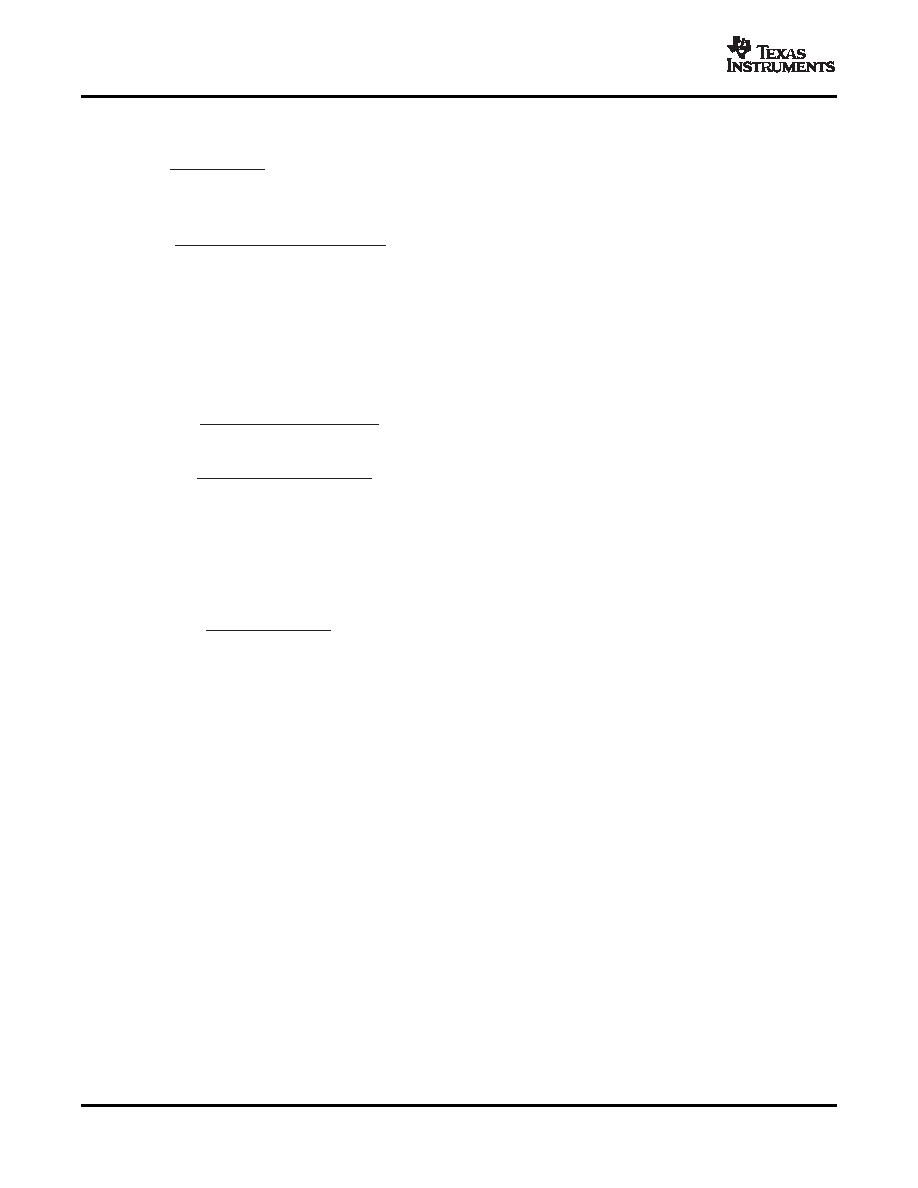- 您現(xiàn)在的位置:買賣IC網(wǎng) > PDF目錄98281 > TPS40075RHLR (TEXAS INSTRUMENTS INC) 2 A SWITCHING CONTROLLER, 1000 kHz SWITCHING FREQ-MAX, PQCC20 PDF資料下載
參數(shù)資料
| 型號: | TPS40075RHLR |
| 廠商: | TEXAS INSTRUMENTS INC |
| 元件分類: | 穩(wěn)壓器 |
| 英文描述: | 2 A SWITCHING CONTROLLER, 1000 kHz SWITCHING FREQ-MAX, PQCC20 |
| 封裝: | PLASTIC, QFN-20 |
| 文件頁數(shù): | 13/44頁 |
| 文件大小: | 806K |
| 代理商: | TPS40075RHLR |
第1頁第2頁第3頁第4頁第5頁第6頁第7頁第8頁第9頁第10頁第11頁第12頁當前第13頁第14頁第15頁第16頁第17頁第18頁第19頁第20頁第21頁第22頁第23頁第24頁第25頁第26頁第27頁第28頁第29頁第30頁第31頁第32頁第33頁第34頁第35頁第36頁第37頁第38頁第39頁第40頁第41頁第42頁第43頁第44頁

www.ti.com
I
SCP u
C
OUT
V
OUT
t
START
) ILOAD (A)
(7)
R
ILIM +
I
SCP
R
DS(onMAX) ) VILIM (ofst)
I
ILIM
W
(8)
I
SCP(max) +
I
ILIM(max)
R
ILIM ) 50 mV
R
DS(onMIN)
A
(9)
I
SCP(min) +
I
ILIM(min)
R
ILIM ) 10 mV
R
DS(onMAX)
A
(10)
C
ILIM(max) +
V
OUT
0.2
V
IN
R
ILIM
f
SW
(Farads)
(11)
BOOST AND DBP BYPASS CAPACITANCE
INTERNAL REGULATORS
SLUS676A – MAY 2006 – REVISED SEPTEMBER 2007
The minimum short circuit limit threshold (ISCP) depends on tSTART, COUT, VOUT, and the load current at turn-on
(ILOAD).
The short circuit limit programming resistor (RILIM) is calculated from:
where
I
ILIM is the current into the ILIM pin (135 μA typical)
V
ILIM(ofst) is the offset voltage of the ILIM comparator (-30 mV typical)
I
SCP is the short-circuit protection current
R
DS(on)MAX is the drain-to-source resistance of the high-side MOSFET
To find the range of the short circuit threshold values use the following equations.
The TPS40075 provides short-circuit protection only. As such, it is recommended that the minimum short circuit
protection level be placed at least 20% above the maximum output current required from the converter. The
maximum output of the converter should be the steady state maximum output plus any transient specification
that may exist.
The ILIM capacitor maximum value can be found from:
Note that this is a recommended maximum value. If a smaller value can be used, it should be to improve
protection. For most applications, consider using half the maximum value shown in Equation 11.
The BOOST capacitance provides a local, low-impedance flying source for the high-side driver. The BOOST
capacitor should be a good quality, high-frequency ceramic capacitor. A minimum value of 100-nF is suggested.
The DBP capacitor has to provide energy storage for switching both the synchronous MOSFET and the high-side
MOSFET (via the BOOST capacitor). The suggested value for this capacitor is 1-
μF ceramic, minimum.
The internal regulators are linear regulators that provide controlled voltages for the drivers and the internal
circuitry to operate from. The low-side driver operates directly from the 8-V regulator supply while the high-side
driver bootstrap capacitor is charged from this supply. The actual voltage delivered to the high-side driver is the
voltage on the DBP pin less any drop from the bootstrap diode. If the internal bootstrap diode is used, the drop
across that diode is nominally 1.4 V at room temperature. This regulator has two modes of operation. At voltages
below 8.5 V on VDD, the regulator is in a low dropout mode of operation and tries to provide as little impedance
as possible from VDD to DBP. When VDD is above 10 V, the regulator regulates DBP to 8 V. Between these two
voltages, the regulator is in whatever state it was in when VDD entered this region. The LVBP pin is connected
to a 4.2-V regulator that supplies power for the internal control circuitry. Small amounts of current can be drawn
from these pins for other external circuit functions, as long as power dissipation in the controller chip remains at
acceptable levels and junction temperature does not exceed 125
°C. Any external load connected to LVBP should
be electrically quiet to avoid degrading performance of the TPS40075. Typical output voltages for these two
regulators are shown in Figure 23 and Figure 24.
20
Copyright 2006–2007, Texas Instruments Incorporated
Product Folder Link(s) :TPS40075
相關(guān)PDF資料 |
PDF描述 |
|---|---|
| TPS40075RHLTG4 | 2 A SWITCHING CONTROLLER, 1000 kHz SWITCHING FREQ-MAX, PQCC20 |
| TPS40077PWPR | 2 A SWITCHING CONTROLLER, 1000 kHz SWITCHING FREQ-MAX, PDSO16 |
| TPS40077PWPRG4 | 2 A SWITCHING CONTROLLER, 1000 kHz SWITCHING FREQ-MAX, PDSO16 |
| TPS40077PWPG4 | 2 A SWITCHING CONTROLLER, 1000 kHz SWITCHING FREQ-MAX, PDSO16 |
| TPS40090QPWRQ1 | SWITCHING CONTROLLER, 1200 kHz SWITCHING FREQ-MAX, PDSO24 |
相關(guān)代理商/技術(shù)參數(shù) |
參數(shù)描述 |
|---|---|
| TPS40075RHLRG4 | 功能描述:DC/DC 開關(guān)控制器 Wide Input Synch Buck Controller RoHS:否 制造商:Texas Instruments 輸入電壓:6 V to 100 V 開關(guān)頻率: 輸出電壓:1.215 V to 80 V 輸出電流:3.5 A 輸出端數(shù)量:1 最大工作溫度:+ 125 C 安裝風格: 封裝 / 箱體:CPAK |
| TPS40075RHLT | 功能描述:DC/DC 開關(guān)控制器 Wide Input Synch Buck Controller RoHS:否 制造商:Texas Instruments 輸入電壓:6 V to 100 V 開關(guān)頻率: 輸出電壓:1.215 V to 80 V 輸出電流:3.5 A 輸出端數(shù)量:1 最大工作溫度:+ 125 C 安裝風格: 封裝 / 箱體:CPAK |
| TPS40075RHLTG4 | 功能描述:DC/DC 開關(guān)控制器 Wide Input Synch Buck Controller RoHS:否 制造商:Texas Instruments 輸入電壓:6 V to 100 V 開關(guān)頻率: 輸出電壓:1.215 V to 80 V 輸出電流:3.5 A 輸出端數(shù)量:1 最大工作溫度:+ 125 C 安裝風格: 封裝 / 箱體:CPAK |
| TPS40077 | 制造商:TI 制造商全稱:Texas Instruments 功能描述:HIGH-EFFICIENCY, MIDRANGE-INPUT, SYNCHRONOUS BUCK CONTROLLER WITH VOLTAGE FEED-FORWARD |
| TPS40077_07 | 制造商:TI 制造商全稱:Texas Instruments 功能描述:HIGH-EFFICIENCY, MIDRANGE-INPUT, SYNCHRONOUS BUCK CONTROLLER WITH VOLTAGE FEED-FORWARD |
發(fā)布緊急采購,3分鐘左右您將得到回復。